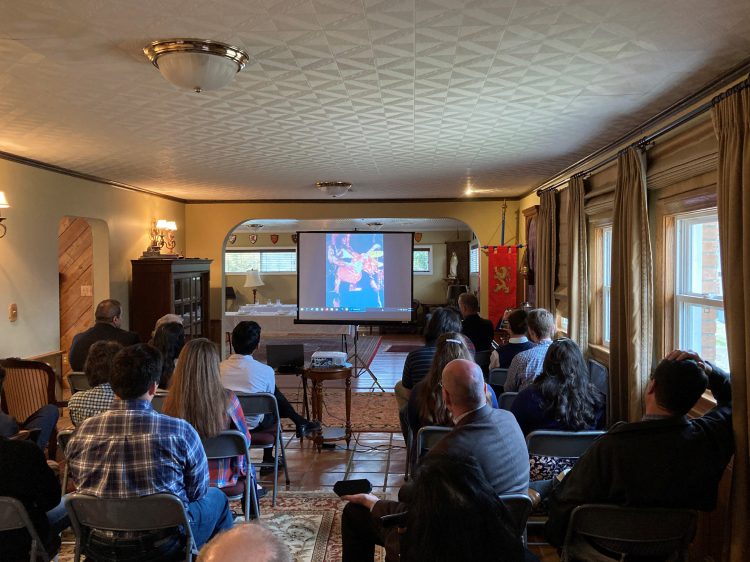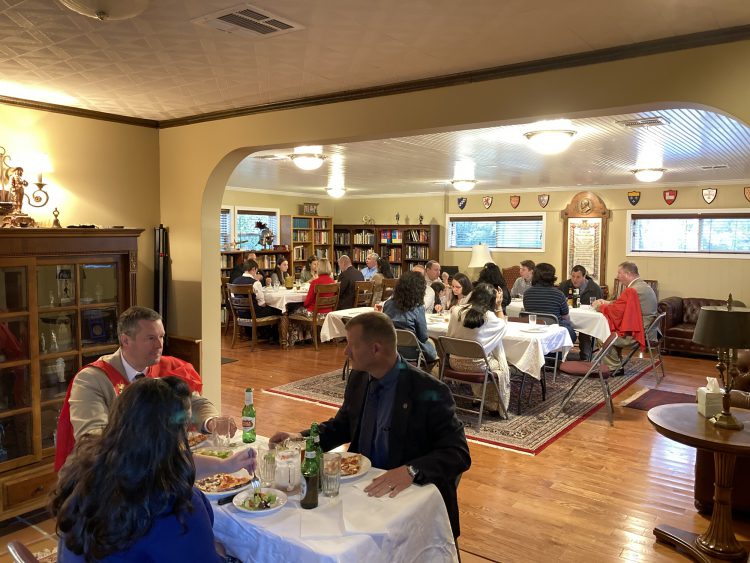On February 27, 2021, over 40 supporters and friends of Tradition, Family, Property (TFP) gathered at the TFP-Louisiana headquarters in Lafayette for a presentation by TFP-Louisiana President Thomas Drake. The topic was “The Rock ‘n’ Roll Revolution. Mr. Drake’s purpose was to explain that “without the Rock ‘n’ Roll Revolution, the Sexual Revolution of the sixties and seventies would never have happened.”

In 1959, Professor Plinio Corrêa de Oliveira, the founder of the Brazilian TFP, prophetically described the rock-and-roll generation with these words in his book Revolution and Counter-Revolution:
The revolutionary process in souls… produced in the most recent generations, and especially in adolescents of our days who hypnotize themselves with rock and roll, a frame of mind characterized by the spontaneity of the primary reactions, without the control of the intelligence or the effective participation of the will, and by the predominance of fantasy and feelings over the methodical analysis of reality. All this is fruit, in large measure, of a pedagogy that virtually eliminates the role of logic and the true formation of the will.
Rock bands mesmerized audiences with the pulsating primal rhythms of electric guitars and drums, coupled with the hypnotic melodies and lyrics filled with sexual innuendo. The message was one of sexual desires and anarchic freedom from Christian societal norms. These songs fanned the disordered passions of a generation of teens and paved the way for the immoral sexual license of the sixties and beyond.
The Rock ‘n’ Roll Revolution subtly spawned a new religion in which the rock stars were idolized as gods. They set negative trends in fashion, language, behavior, morals, ideas and politics.
Revolution Within the Catholic Church
Mr. Drake began the talk with examples of rock music’s influence within the Catholic Church beginning in the early sixties.
The first example was the Dominican nun Sister Luc Gabriel in Belgium. In 1963, she became a worldwide singing sensation with the release of her French-language single “Dominique.” She was known as the “Singing Nun” as her song reached the top of the charts in America and the world. In 1966, Hollywood made a movie about her rise to fame with actress Debbie Reynolds portraying Sister Luc.
Sister Luc’s story ended tragically. When her fame waned, she experienced a crisis of Faith, and left the Dominican Order. She endured financial hardships, and committed suicide with her female partner in 1985.
Mr. Drake also presented other examples of guitar-playing singing nuns and monks from the sixties and beyond.
The Rock ‘n’ Roll Mass
In the early seventies, the Rock ‘n’ Roll Mass began with rock-infused liturgical music and worship songs incorporated within the New Mass.
This trend soon became widespread in Catholic worship, often encouraged by the clergy. Such Masses and its variant forms continued even today in many parishes.
Christian Rock Music
The lecturer also criticized so-called Christian Rock. Despite Christian rockers’ insistence that they sing songs of worship to God, they dress and behave on stage just like “non-Christian” Rock bands. They can be found in immodest clothing gyrating wildly with their guitars and microphones. They also use the same stage effects, full of vividly hellish colors flashing frenetically, coupled with smoke and fire pyrotechnics.
There is a contradiction between the song lyrics praising God and the Holy Spirit and their onstage delivery.
The History of Rock and Roll
Mr. Drake presented a one-hour video documentary on the history of Rock ‘n’ Roll starting with its origins in African American Blues and jazz music of the early twentieth century.
From the thirties to the fifties, the music developed with the melding of gospel, jump blues, jazz, boogie-woogie, swing, rhythm and blues and country music. Bill Haley and the Comets, Elvis Presley, Little Richard, Jerry Lee Lewis and Chuck Berry were the first popular exponents of this new form of music in the fifties.
Audiences reacted wildly to the new music as if they were compelled by some irresistible force to scream and tear up their seats. The documentary also explored and illustrated the immoral lives of these rock stars ranging from Elvis to Chuck Berry to Jerry Lee Lewis.
In the sixties and seventies, Rock artists began incorporating occult and Satanic themes in their melodies, lyrics, and album art-work. Famous occultists and gurus who influenced singers included English gnostic occultist Aleister Crowley (1875 – 1947), Church of Satan founder Anton LeVay (1930 – 1997), Indian guru Maharishi Mahesh Yogi (1918 – 2008) and Kenneth Anger, producer of the film “Lucifer Rising.”
Popular Rock bands and performers later openly praised and worshiped Satan and the occult in the music. Secret messages about worshiping Satan on albums spun backwards soon paved the way to overt praise in the songs. During live concert performances, the set portrayed scenes that seemed from Hell. Rock bands and performers of this sort included Led Zeppelin, Black Sabbath, Judas Priest, KISS, AC/DC, Alice Cooper and Ozzy Osbourne.
Ipsa Conteret
After the documentary ended with a note of victory that is guaranteed by Scriptures. Genesis 3:15 says, “I will put enmities between thee [the serpent] and the woman [Mary], and thy seed and her seed: she shall crush thy head, and thou shalt lie in wait for her heel.”
Since the Fall of Adam, God in His Justice and Mercy has guaranteed victory over Satan and his acolytes. Our Lady at Fatima in 1917, repeated that message when she said that, “Finally, My Immaculate Heart will triumph.”
Mr. Drake concluded his talk with words of encouragement calling upon those present to have calm, courage, and confidence in the face of Our Lady’s promise that She (and her children) will be victorious.
Pizza, Convivium and a Tour
Immediately after the presentation, everyone enjoyed a pizza dinner, conviviality and conversation. The pizza was homemade and baked in the outdoor Italian pizza oven by TFP members.

The attendees then left the TFP-Louisiana headquarters spiritually reinvigorated with a more developed understanding of the Rock ‘n’ Roll Revolution and its effects on society. They were prepared to engage in the spiritual battles required of a faithful Catholic today.
by Joseph Andrepont